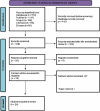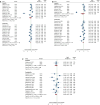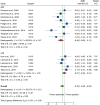Clinical effects of probiotics on the treatment of gingivitis and periodontitis: a systematic review and meta-analysis
- PMID: 40186219
- PMCID: PMC11971800
- DOI: 10.1186/s12903-025-05888-5
Clinical effects of probiotics on the treatment of gingivitis and periodontitis: a systematic review and meta-analysis
Abstract
Aims: This study aimed to evaluate the impact of probiotics as an adjunct to periodontal therapy on clinical outcomes in patients with gingivitis and periodontitis through a meta-analysis of available evidence.
Materials and methods: A detailed bibliographic search on four databases (PubMed, Scopus, Cochrane and EMBASE) was conducted with a language restriction. The collected data were assessed according to the predefined eligibility criteria and randomized clinical trials reporting the effects of probiotics on plaque index (PI), bleeding on probing (BOP) and pocket probing depth (PPD) compared to control or placebo groups were selected and analysed. The risk of bias assessment was conducted using SYRCLE's RoB- 2 tool. The GRADEpro tool was used to determine the overall quality of evidence.
Results: Twenty-four studies (10 about gingivitis and 14 about periodontitis) were included in the meta-analysis. In the gingivitis studies, lower but non-significant PI and BOP were found in the probiotic group. In periodontitis, lower PI (95%-CI [- 0.54; - 0.15], p = 0.001) were reported in the probiotic group, and this difference was greater in studies with longer follow-up. Lower BOP (95%-CI [- 0.58; - 0.05], p = 0.021) was also reported, but this difference was only significant in studies with a shorter follow-up (95%-CI [- 0.86; - 0.11], p = 0.012). Meta-analysis for PPD showed lower, but non-significant, values (95%-CI [- 0.53; + 0.03], p = 0.077). However, this difference became significant when assessing studies with shorter follow-up (95% CI [- 0.77; - 0.07], p = 0.019).
Conclusions: The meta-analysis provides evidence suggested that probiotics can serve as a beneficial adjunct to periodontal treatment in patients with periodontitis, particularly in improving clinical outcomes such as plaque index and bleeding on probing. The results from gingivitis studies highlight the need for further investigation to better understand the impact of probiotics in the early stages of periodontal disease. These findings emphasize the importance of future research with standardized protocols and longer follow-up periods to confirm and expand on the clinical utility of probiotics in periodontal therapy.
Keywords: Gingivitis; Meta-analysis; Periodontitis; Probiotics; Systematic review.
© 2025. The Author(s).
Conflict of interest statement
Declarations. Ethics approval and consent to participate: Not applicable. Consent for publication: Not applicable. Competing interests: The authors declare no competing interests.
Figures







References
-
- Slots J. Periodontology: past, present, perspectives. Periodontol 2000. 2013;62(1):7–19. - PubMed
-
- Tonetti MS, Sanz M. Implementation of the new classification of periodontal diseases: Decision-making algorithms for clinical practice and education. J Clin Periodontol. 2019;46(4):398–405. - PubMed
-
- Ho SN, Acharya A, Sidharthan S, Li KY, Leung WK, McGrath C, Pelekos G. A Systematic Review and Meta-analysis of Clinical, Immunological, and Microbiological Shift in Periodontitis After Nonsurgical Periodontal Therapy With Adjunctive Use of Probiotics. J Evid Based Dent Pract. 2020;20(1): 101397. - PubMed
-
- Morales A, Galaz C, González J, Silva N, Hernández M, Godoy C, García-Sesnich J, Díaz P, Carvajal P. Efecto clínico del uso de probiótico en el tratamiento de la periodontitis crónica: ensayo clínico. Revista Clínica de Periodoncia, Implantología y Rehabilitación Oral. 2016;9(2):146–52.
-
- Dhingra K. Methodological issues in randomized trials assessing probiotics for periodontal treatment. J Periodontal Res. 2012;47(1):15–26. - PubMed
Publication types
MeSH terms
LinkOut - more resources
Full Text Sources
Research Materials
Miscellaneous

